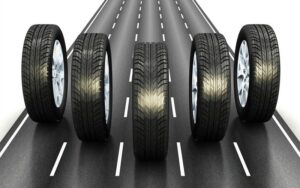
As we have seen, each vehicle has its own tire size. It is imperative to respect this size, it is in the law. Technical inspection requires it.
On the other hand, the choice of model and manufacturer is completely free! As long as it meets the vehicle manufacturer’s instructions, a tire can be fitted with complete peace of mind.
Tires for a city car must combine safety, longevity and low consumption. Concerning the tires of a sedan, the rubber must be versatile and ensure good performance as well as optimal driving comfort.
The tires of a sports car are expected for handling and precision. In addition to a high level of performance, they must be responsive in terms of braking distance.
WHICH TIRE FOR YOUR DRIVING STYLE?
Choosing your tires wisely means opting for those that correspond to the driver and his behavior. It is therefore important to know and identify your driving habits:
Do you drive a lot on the highway?
The location of your home is an important criterion. Living in a mountainous and winding region will direct the choice towards a different model of tire use in an area less exposed to difficult weather conditions.
Motorists who drive soberly will opt for a versatile and reliable tire such as the Continental AllSeasonContact all-season touring tire or the Michelin Primacy 4 tire. More sporty drivers will favor the ContiSportContact 5 from Continental or the Pirelli P Zero.
WHAT ARE THE DIFFERENCES BETWEEN SUMMER, ALL-SEASON AND WINTER TIRES?
If the choice of tire is made according to the region and the climate, the season is also important. The summer tire is the most common because it allows you to drive in all climates, whether the road is dry or wet. On the other hand, its performance will be limited if the weather conditions deteriorate significantly.
When temperatures fall below 7°, the winter tire then has characteristics offering good performance on wet and snowy asphalt.
Winter tires have many sipes and wider, deeper grooves. These features optimize the braking distance and promote the evacuation of water, snow and even mud.
A 4-season tire is also an economical choice, so as not to have to swap summer tires and winter tires every year when you do not live in a region subject to the obligations of the Mountain II law.
What is the tire manufacturer’s marking?
If all tires on the market are approved, some also have the manufacturer’s marking. The latter is written on the sidewall of the tire: example MO for Mercedes.
The manufacturer marking results from a partnership between high-end car brands (Mercedes, Audi, BMW, Ferrari, etc.) and manufacturers.
To appear as original equipment for the vehicle, as is the case for Continental with many major brands, the tire manufacturer must respect the manufacturer’s specifications. The final objective is to offer the product that is best suited to the car as possible.
The difference with models without marking is mainly in the construction of the tire and the rubber. The dimensions and designs of the tread remain almost identical.
A tire is rated from A to F regarding rolling resistance and wet grip. A is therefore the best grade and F the worst.
When choosing tires, it is important to look at the European labeling since rolling resistance affects fuel consumption and grip affects safety. This labeling is mandatory for tires of passenger cars and light and heavy commercial vehicles.
You should know that winter tires often have lower ratings. The winter version is already designed and designed to improve braking safety and handling in difficult conditions.
The summer tire does not have the same performance in these conditions. The added safety provided by the winter range justifies the difference in rating observed on the European tire criteria.




